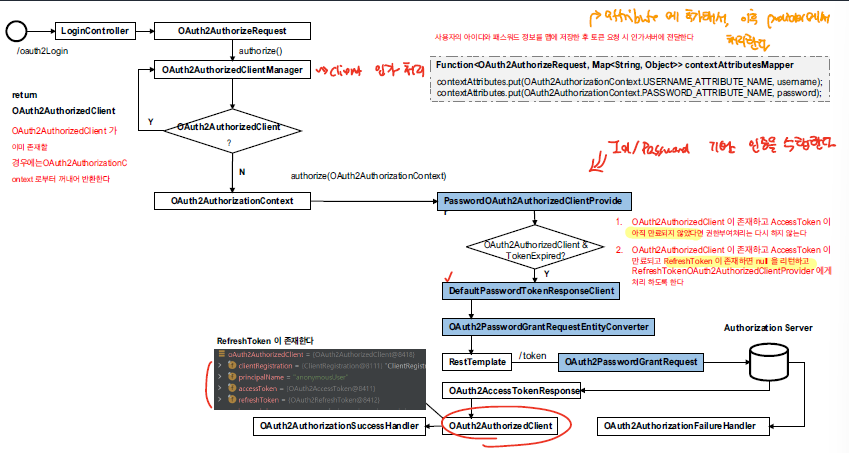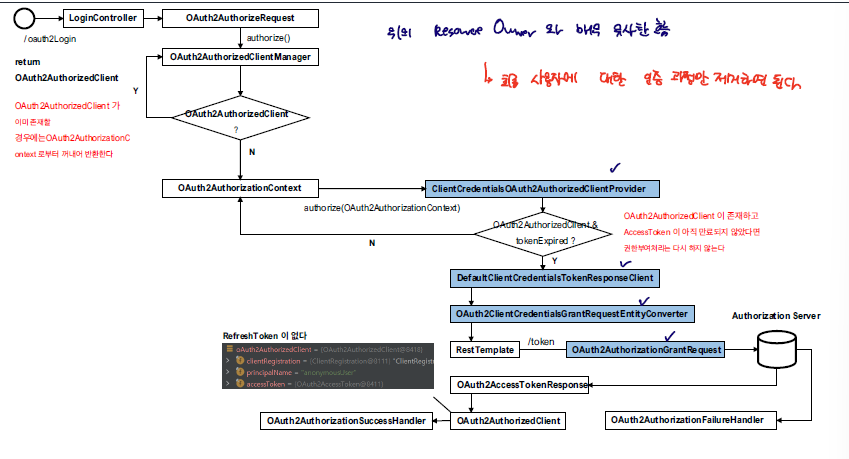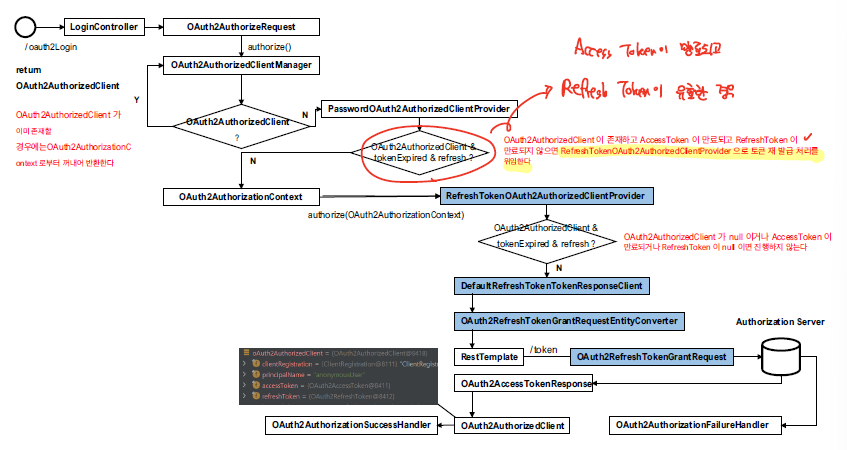Spring Security Oauth2 Part 6
OAuth2 Client
OAuth2 Client 방식의 인증을 살펴보자.
OAuth2Login
- Authorization Code 발급
- Access Token 발급
- UserInfo 요청 –> 최종 사용자 인증
OAuth2Client
- Authorization Code 발급
- Access Token 발급
OAuth2Client는 OAuth2Login 과정에서 최종 사용자에 대한 인증을 제외한 과정까지 진행하게 된다. 따라서, 이후 최종 사용자에 대한 인증은 과정은 직접 구현해야한다.
OAuth2AuthorizationCodeGrantFilter
LoginAuthenticationFilter 대신, CodeGrantFilter가 동작하는데, 사용자 인증을 제외한 과정을 처리한다. 아래의 코드를 보면 알듯이, Authentication 객체를 반환하지 않고 단순히 OAutheAuthorizedClient을 저장해서 Redirect Uri로 이동하는 작업을 수행한다.
LoginAuthenticationFilter
@Override
public Authentication attemptAuthentication(HttpServletRequest request, HttpServletResponse response)
throws AuthenticationException {
MultiValueMap<String, String> params = OAuth2AuthorizationResponseUtils.toMultiMap(request.getParameterMap());
if (!OAuth2AuthorizationResponseUtils.isAuthorizationResponse(params)) {
OAuth2Error oauth2Error = new OAuth2Error(OAuth2ErrorCodes.INVALID_REQUEST);
throw new OAuth2AuthenticationException(oauth2Error, oauth2Error.toString());
}
OAuth2AuthorizationRequest authorizationRequest = this.authorizationRequestRepository
.removeAuthorizationRequest(request, response);
if (authorizationRequest == null) {
OAuth2Error oauth2Error = new OAuth2Error(AUTHORIZATION_REQUEST_NOT_FOUND_ERROR_CODE);
throw new OAuth2AuthenticationException(oauth2Error, oauth2Error.toString());
}
String registrationId = authorizationRequest.getAttribute(OAuth2ParameterNames.REGISTRATION_ID);
ClientRegistration clientRegistration = this.clientRegistrationRepository.findByRegistrationId(registrationId);
if (clientRegistration == null) {
OAuth2Error oauth2Error = new OAuth2Error(CLIENT_REGISTRATION_NOT_FOUND_ERROR_CODE,
"Client Registration not found with Id: " + registrationId, null);
throw new OAuth2AuthenticationException(oauth2Error, oauth2Error.toString());
}
// @formatter:off
String redirectUri = UriComponentsBuilder.fromHttpUrl(UrlUtils.buildFullRequestUrl(request))
.replaceQuery(null)
.build()
.toUriString();
// @formatter:on
OAuth2AuthorizationResponse authorizationResponse = OAuth2AuthorizationResponseUtils.convert(params,
redirectUri);
Object authenticationDetails = this.authenticationDetailsSource.buildDetails(request);
OAuth2LoginAuthenticationToken authenticationRequest = new OAuth2LoginAuthenticationToken(clientRegistration,
new OAuth2AuthorizationExchange(authorizationRequest, authorizationResponse));
authenticationRequest.setDetails(authenticationDetails);
OAuth2LoginAuthenticationToken authenticationResult = (OAuth2LoginAuthenticationToken) this
.getAuthenticationManager().authenticate(authenticationRequest);
OAuth2AuthenticationToken oauth2Authentication = this.authenticationResultConverter
.convert(authenticationResult);
Assert.notNull(oauth2Authentication, "authentication result cannot be null");
oauth2Authentication.setDetails(authenticationDetails);
OAuth2AuthorizedClient authorizedClient = new OAuth2AuthorizedClient(
authenticationResult.getClientRegistration(), oauth2Authentication.getName(),
authenticationResult.getAccessToken(), authenticationResult.getRefreshToken());
this.authorizedClientRepository.saveAuthorizedClient(authorizedClient, oauth2Authentication, request, response);
return oauth2Authentication;
}
CodeGrantFilter
private void processAuthorizationResponse(HttpServletRequest request, HttpServletResponse response)
throws IOException {
OAuth2AuthorizationRequest authorizationRequest = this.authorizationRequestRepository
.removeAuthorizationRequest(request, response);
String registrationId = authorizationRequest.getAttribute(OAuth2ParameterNames.REGISTRATION_ID);
ClientRegistration clientRegistration = this.clientRegistrationRepository.findByRegistrationId(registrationId);
MultiValueMap<String, String> params = OAuth2AuthorizationResponseUtils.toMultiMap(request.getParameterMap());
String redirectUri = UrlUtils.buildFullRequestUrl(request);
OAuth2AuthorizationResponse authorizationResponse = OAuth2AuthorizationResponseUtils.convert(params,
redirectUri);
OAuth2AuthorizationCodeAuthenticationToken authenticationRequest = new OAuth2AuthorizationCodeAuthenticationToken(
clientRegistration, new OAuth2AuthorizationExchange(authorizationRequest, authorizationResponse));
authenticationRequest.setDetails(this.authenticationDetailsSource.buildDetails(request));
OAuth2AuthorizationCodeAuthenticationToken authenticationResult;
try {
authenticationResult = (OAuth2AuthorizationCodeAuthenticationToken) this.authenticationManager
.authenticate(authenticationRequest);
}
catch (OAuth2AuthorizationException ex) {
OAuth2Error error = ex.getError();
UriComponentsBuilder uriBuilder = UriComponentsBuilder.fromUriString(authorizationRequest.getRedirectUri())
.queryParam(OAuth2ParameterNames.ERROR, error.getErrorCode());
if (!StringUtils.isEmpty(error.getDescription())) {
uriBuilder.queryParam(OAuth2ParameterNames.ERROR_DESCRIPTION, error.getDescription());
}
if (!StringUtils.isEmpty(error.getUri())) {
uriBuilder.queryParam(OAuth2ParameterNames.ERROR_URI, error.getUri());
}
this.redirectStrategy.sendRedirect(request, response, uriBuilder.build().encode().toString());
return;
}
Authentication currentAuthentication = this.securityContextHolderStrategy.getContext().getAuthentication();
String principalName = (currentAuthentication != null) ? currentAuthentication.getName() : "anonymousUser";
OAuth2AuthorizedClient authorizedClient = new OAuth2AuthorizedClient(
authenticationResult.getClientRegistration(), principalName, authenticationResult.getAccessToken(),
authenticationResult.getRefreshToken());
this.authorizedClientRepository.saveAuthorizedClient(authorizedClient, currentAuthentication, request,
response);
String redirectUrl = authorizationRequest.getRedirectUri();
SavedRequest savedRequest = this.requestCache.getRequest(request, response);
if (savedRequest != null) {
redirectUrl = savedRequest.getRedirectUrl();
this.requestCache.removeRequest(request, response);
}
this.redirectStrategy.sendRedirect(request, response, redirectUrl);
}
OAuth2AuthorizedClientManager
OAuth2AuthorizedClient를 전반적으로 관리하는 객체로, 각 권한 부여에 맞는 Provider을 실행하여 실제 권한 부여 흐름에 맞게 처리를 수행하고 OAuth2AuthorizedClient을 최종적으로 반환한다. 다음과 같이 필요한 Provider을 생성해서 Client Manager에 설정한 DefaultOAuth2AuthorizedClientManager 객체를 Bean으로 등록하여 이후 인증 과정에서 사용할 수 있도록 한다.
@Bean
public DefaultOAuth2AuthorizedClientManager oAuth2AuthorizedClientManager(ClientRegistrationRepository clientRegistrationRepository, OAuth2AuthorizedClientRepository oAuth2AuthorizedClientRepository) {
OAuth2AuthorizedClientProvider oAuth2AuthorizedClientProvider = OAuth2AuthorizedClientProviderBuilder.builder()
.authorizationCode()
.password(passwordGrantBuilder -> passwordGrantBuilder.clockSkew(Duration.ofSeconds(3600)))
.clientCredentials()
.refreshToken(refreshTokenGrantBuilder -> refreshTokenGrantBuilder.clockSkew(Duration.ofSeconds(3600)))
.build();
OAuth2AuthorizationSuccessHandler authorizationSuccessHandler = (authorizedClient, principal, attributes) -> oAuth2AuthorizedClientRepository
.saveAuthorizedClient(authorizedClient, principal,
(HttpServletRequest) attributes.get(HttpServletRequest.class.getName()),
(HttpServletResponse) attributes.get(HttpServletResponse.class.getName()));
DefaultOAuth2AuthorizedClientManager oAuth2AuthorizedClientManager = new DefaultOAuth2AuthorizedClientManager(clientRegistrationRepository,oAuth2AuthorizedClientRepository);
oAuth2AuthorizedClientManager.setAuthorizedClientProvider(oAuth2AuthorizedClientProvider);
oAuth2AuthorizedClientManager.setAuthorizationSuccessHandler(authorizationSuccessHandler);
return oAuth2AuthorizedClientManager;
}
OAuth2 Client을 활용하여 로그인 처리
- /oauth2Login으로 요청을 보내 권한 부여 흐름을 요청한다.
@GetMapping("/oauth2Login")
public String oauth2Login(Model model, HttpServletRequest request, HttpServletResponse response) {
Authentication authentication = SecurityContextHolder.getContext().getAuthentication();
OAuth2AuthorizeRequest oAuth2AuthorizeRequest = OAuth2AuthorizeRequest.withClientRegistrationId("keycloak")
.principal(authentication)
.attribute(HttpServletRequest.class.getName(), request)
.attribute(HttpServletResponse.class.getName(), response)
.build();
OAuth2AuthorizedClient authorizedClient = oAuth2AuthorizedClientManager.authorize(oAuth2AuthorizeRequest);
}
-
DefaultOAuth2AuthorizedClientManager을 활용하여 권한 부여 흐름을 처리한다.
-
이후, OAuth2AuthorizedClient을 활용하여 /userinfo에 대한 요청으로 사용자 정보를 받와서 인증객체를 만들어낸다.
if(oAuth2AuthorizedClient != null) {
ClientRegistration clientRegistration = oAuth2AuthorizedClient.getClientRegistration();
OAuth2AccessToken accessToken = oAuth2AuthorizedClient.getAccessToken();
OAuth2RefreshToken refreshToken = oAuth2AuthorizedClient.getRefreshToken();
OAuth2UserService oAuth2UserService = new DefaultOAuth2UserService();
OAuth2User oauth2User = oAuth2UserService.loadUser(new OAuth2UserRequest(
oAuth2AuthorizedClient.getClientRegistration(), accessToken));
SimpleAuthorityMapper simpleAuthorityMapper = new SimpleAuthorityMapper();
Collection<? extends GrantedAuthority> authorities = simpleAuthorityMapper.mapAuthorities(oauth2User.getAuthorities());
OAuth2AuthenticationToken oAuth2AuthenticationToken = new OAuth2AuthenticationToken(oauth2User, authorities, clientRegistration.getRegistrationId());
authorizationSuccessHandler.onAuthorizationSuccess(oAuth2AuthorizedClient, oAuth2AuthenticationToken, createAttributes(request, response));
return oAuth2AuthenticationToken;
}
권한 부여 흐름 처리
전체적인 흐름은 OAuth2ClientManager에서 정의한 대로 진행하지만 각 권한 부여 흐름에 따라 그에 맞는 Provider가 동작하게 된다.
@Override
@Nullable
public OAuth2AuthorizedClient authorize(OAuth2AuthorizationContext context) {
Assert.notNull(context, "context cannot be null");
for (OAuth2AuthorizedClientProvider authorizedClientProvider : this.authorizedClientProviders) {
OAuth2AuthorizedClient oauth2AuthorizedClient = authorizedClientProvider.authorize(context);
if (oauth2AuthorizedClient != null) {
return oauth2AuthorizedClient;
}
}
return null;
}
Resource Owner Flow

@Override
@Nullable
public OAuth2AuthorizedClient authorize(OAuth2AuthorizationContext context) {
Assert.notNull(context, "context cannot be null");
ClientRegistration clientRegistration = context.getClientRegistration();
OAuth2AuthorizedClient authorizedClient = context.getAuthorizedClient();
if (!AuthorizationGrantType.PASSWORD.equals(clientRegistration.getAuthorizationGrantType())) {
return null;
}
String username = context.getAttribute(OAuth2AuthorizationContext.USERNAME_ATTRIBUTE_NAME);
String password = context.getAttribute(OAuth2AuthorizationContext.PASSWORD_ATTRIBUTE_NAME);
if (!StringUtils.hasText(username) || !StringUtils.hasText(password)) {
return null;
}
if (authorizedClient != null && !hasTokenExpired(authorizedClient.getAccessToken())) {
// If client is already authorized and access token is NOT expired than no
// need for re-authorization
return null;
}
if (authorizedClient != null && hasTokenExpired(authorizedClient.getAccessToken())
&& authorizedClient.getRefreshToken() != null) {
// If client is already authorized and access token is expired and a refresh
// token is available, than return and allow
// RefreshTokenOAuth2AuthorizedClientProvider to handle the refresh
return null;
}
OAuth2PasswordGrantRequest passwordGrantRequest = new OAuth2PasswordGrantRequest(clientRegistration, username,
password);
OAuth2AccessTokenResponse tokenResponse = getTokenResponse(clientRegistration, passwordGrantRequest);
return new OAuth2AuthorizedClient(clientRegistration, context.getPrincipal().getName(),
tokenResponse.getAccessToken(), tokenResponse.getRefreshToken());
}
Password 방식의 경우 Attribute에 username, password을 담아서 전달해야 한다. 이 과정은 ClientManager을 초기화하는 과정에서 AttributeMapper을 등록하는 작업을 통해 이루어진다.
DefaultOAuth2AuthorizedClientManager oAuth2AuthorizedClientManager = new DefaultOAuth2AuthorizedClientManager(clientRegistrationRepository,oAuth2AuthorizedClientRepository);
oAuth2AuthorizedClientManager.setContextAttributesMapper(contextAttributesMapper());
private Function<OAuth2AuthorizeRequest, Map<String, Object>> contextAttributesMapper() {
return oAuth2AuthorizeRequest -> {
Map<String, Object> contextAttributes = new HashMap<>();
HttpServletRequest request = oAuth2AuthorizeRequest.getAttribute(HttpServletRequest.class.getName());
String username = request.getParameter(OAuth2ParameterNames.USERNAME);
String password = request.getParameter(OAuth2ParameterNames.PASSWORD);
if (StringUtils.hasText(username) && StringUtils.hasText(password)) {
contextAttributes.put(OAuth2AuthorizationContext.USERNAME_ATTRIBUTE_NAME, username);
contextAttributes.put(OAuth2AuthorizationContext.PASSWORD_ATTRIBUTE_NAME, password);
}
return contextAttributes;
};
}
Client Credentials

client credentials 방식도 마찬가지로, ClientCredentialsOAuth2AuthroizedClientProvider가 동작한다.
@Override
@Nullable
public OAuth2AuthorizedClient authorize(OAuth2AuthorizationContext context) {
Assert.notNull(context, "context cannot be null");
ClientRegistration clientRegistration = context.getClientRegistration();
if (!AuthorizationGrantType.CLIENT_CREDENTIALS.equals(clientRegistration.getAuthorizationGrantType())) {
return null;
}
OAuth2AuthorizedClient authorizedClient = context.getAuthorizedClient();
if (authorizedClient != null && !hasTokenExpired(authorizedClient.getAccessToken())) {
// If client is already authorized but access token is NOT expired than no
// need for re-authorization
return null;
}
// As per spec, in section 4.4.3 Access Token Response
// https://tools.ietf.org/html/rfc6749#section-4.4.3
// A refresh token SHOULD NOT be included.
//
// Therefore, renewing an expired access token (re-authorization)
// is the same as acquiring a new access token (authorization).
OAuth2ClientCredentialsGrantRequest clientCredentialsGrantRequest = new OAuth2ClientCredentialsGrantRequest(
clientRegistration);
OAuth2AccessTokenResponse tokenResponse = getTokenResponse(clientRegistration, clientCredentialsGrantRequest);
return new OAuth2AuthorizedClient(clientRegistration, context.getPrincipal().getName(),
tokenResponse.getAccessToken());
}
Refresh Token

모든 권한 부여흐름을 보면 아래와 같이 Access Token이 유효한지 검증하는 로직이 포함되어있다. 만일 Access Token이 만료되었고 Refresh Token이 유효한 경우에는 Refresh Token을 활용하여 Access Token을 재발급하는 과정이 동작하게 된다.
if (authorizedClient != null && !hasTokenExpired(authorizedClient.getAccessToken())) {
// If client is already authorized and access token is NOT expired than no
// need for re-authorization
return null;
}
if (authorizedClient != null && hasTokenExpired(authorizedClient.getAccessToken())
&& authorizedClient.getRefreshToken() != null) {
// If client is already authorized and access token is expired and a refresh
// token is available, than return and allow
// RefreshTokenOAuth2AuthorizedClientProvider to handle the refresh
return null;
}
@Override
@Nullable
public OAuth2AuthorizedClient authorize(OAuth2AuthorizationContext context) {
Assert.notNull(context, "context cannot be null");
OAuth2AuthorizedClient authorizedClient = context.getAuthorizedClient();
if (authorizedClient == null || authorizedClient.getRefreshToken() == null
|| !hasTokenExpired(authorizedClient.getAccessToken())) {
return null;
}
Object requestScope = context.getAttribute(OAuth2AuthorizationContext.REQUEST_SCOPE_ATTRIBUTE_NAME);
Set<String> scopes = Collections.emptySet();
if (requestScope != null) {
Assert.isInstanceOf(String[].class, requestScope, "The context attribute must be of type String[] '"
+ OAuth2AuthorizationContext.REQUEST_SCOPE_ATTRIBUTE_NAME + "'");
scopes = new HashSet<>(Arrays.asList((String[]) requestScope));
}
OAuth2RefreshTokenGrantRequest refreshTokenGrantRequest = new OAuth2RefreshTokenGrantRequest(
authorizedClient.getClientRegistration(), authorizedClient.getAccessToken(),
authorizedClient.getRefreshToken(), scopes);
OAuth2AccessTokenResponse tokenResponse = getTokenResponse(authorizedClient, refreshTokenGrantRequest);
return new OAuth2AuthorizedClient(context.getAuthorizedClient().getClientRegistration(),
context.getPrincipal().getName(), tokenResponse.getAccessToken(), tokenResponse.getRefreshToken());
}
CustomOAuth2LoginAuthenticationFilter
기존에는 위와 같이 OAuth2ClientManager을 통해 OAuth2AuthorizedClient을 얻어내고, OAuth2AuthorizedClient을 이용해서 최종 사용자 인증을 거치고 OAuthUser을 생성하여 인증 객체를 저장한다.
@GetMapping("/oauth2Login")
public String oauth2Login(Model model, HttpServletRequest request, HttpServletResponse response) {
Authentication authentication = SecurityContextHolder.getContext().getAuthentication();
OAuth2AuthorizeRequest oAuth2AuthorizeRequest = OAuth2AuthorizeRequest.withClientRegistrationId("keycloak")
.principal(authentication)
.attribute(HttpServletRequest.class.getName(), request)
.attribute(HttpServletResponse.class.getName(), response)
.build();
OAuth2AuthorizedClient authorizedClient = oAuth2AuthorizedClientManager.authorize(oAuth2AuthorizeRequest);
if (authorizedClient != null) {
OAuth2UserService<OAuth2UserRequest, OAuth2User> oAuth2UserService = new DefaultOAuth2UserService();
ClientRegistration clientRegistration = authorizedClient.getClientRegistration();
OAuth2AccessToken accessToken = authorizedClient.getAccessToken();
OAuth2UserRequest oAuth2UserRequest = new OAuth2UserRequest(clientRegistration,accessToken);
OAuth2User oAuth2User = oAuth2UserService.loadUser(oAuth2UserRequest);
//등록된 권한에 대해 추가 설정 작업
SimpleAuthorityMapper simpleAuthorityMapper = new SimpleAuthorityMapper();
simpleAuthorityMapper.setPrefix("SYSTEM_");
Set<GrantedAuthority> grantedAuthorities = simpleAuthorityMapper.mapAuthorities(oAuth2User.getAuthorities());
OAuth2AuthenticationToken oAuth2AuthenticationToken = new OAuth2AuthenticationToken(
oAuth2User,grantedAuthorities,clientRegistration.getRegistrationId()
);
SecurityContextHolder.getContext().setAuthentication(oAuth2AuthenticationToken);
model.addAttribute("oAuth2AuthenticationToken", oAuth2AuthenticationToken);
}
model.addAttribute("authorizedClient", authorizedClient.getAccessToken().getTokenValue());
return "home";
}
하지만, 이 과정은 Servlet 내부로 들어와 Controller의 실행을 처리하게 되는데, 이를 Filter로 구성하여 Filter level에서 인증을 처리할 수 있도록 한다.
CustomOAuth2LoginAuthenticationFilter
/oauth2Login으로 요청에 대해 Filter가 동작하도록 하여, 필요한 작업을 처리할 수 있도록 한다.
public class CustomOAuth2LoginAuthenticationFilter extends AbstractAuthenticationProcessingFilter {
public static final String DEFAULT_FILTER_PROCESSES_URI = "/oauth2Login/**";
private OAuth2AuthorizedClientRepository authorizedClientRepository;
private DefaultOAuth2AuthorizedClientManager oAuth2AuthorizedClientManager;
private OAuth2AuthorizationSuccessHandler authorizationSuccessHandler;
private OAuth2AuthorizationFailureHandler authorizationFailureHandler;
private Duration clockSkew = Duration.ofSeconds(3600);
private Clock clock = Clock.systemUTC();
public CustomOAuth2LoginAuthenticationFilter(DefaultOAuth2AuthorizedClientManager oAuth2AuthorizedClientManager, OAuth2AuthorizedClientRepository oAuth2AuthorizedClientRepository) {
super(DEFAULT_FILTER_PROCESSES_URI);
this.oAuth2AuthorizedClientManager = oAuth2AuthorizedClientManager;
this.authorizedClientRepository = oAuth2AuthorizedClientRepository;
this.authorizationSuccessHandler = (authorizedClient, authentication, attributes) ->
authorizedClientRepository
.saveAuthorizedClient(authorizedClient, authentication,
(HttpServletRequest) attributes.get(HttpServletRequest.class.getName()),
(HttpServletResponse) attributes.get(HttpServletResponse.class.getName()));
this.oAuth2AuthorizedClientManager.setAuthorizationSuccessHandler(authorizationSuccessHandler);
}
@Override
public Authentication attemptAuthentication(HttpServletRequest request, HttpServletResponse response) throws AuthenticationException, IOException, ServletException {
Authentication principal = SecurityContextHolder.getContext().getAuthentication();
if (principal == null) {
principal = new AnonymousAuthenticationToken("anonymous","anonymousUser", AuthorityUtils.createAuthorityList("ROLE_ANONYMOUS"));
}
OAuth2AuthorizeRequest authorizeRequest = OAuth2AuthorizeRequest
.withClientRegistrationId("keycloak")
.principal(principal)
.attribute(HttpServletRequest.class.getName(), request)
.attribute(HttpServletResponse.class.getName(), response)
.build();
OAuth2AuthorizedClient oAuth2AuthorizedClient = oAuth2AuthorizedClientManager.authorize(authorizeRequest);
/*if (oAuth2AuthorizedClient != null && hasTokenExpired(oAuth2AuthorizedClient.getAccessToken())
&& oAuth2AuthorizedClient.getRefreshToken() != null) {
ClientRegistration.withClientRegistration(oAuth2AuthorizedClient.getClientRegistration()).authorizationGrantType(AuthorizationGrantType.REFRESH_TOKEN);
oAuth2AuthorizedClient = oAuth2AuthorizedClientManager.authorize(authorizeRequest);
}*/
if(oAuth2AuthorizedClient != null) {
ClientRegistration clientRegistration = oAuth2AuthorizedClient.getClientRegistration();
OAuth2AccessToken accessToken = oAuth2AuthorizedClient.getAccessToken();
OAuth2RefreshToken refreshToken = oAuth2AuthorizedClient.getRefreshToken();
OAuth2UserService oAuth2UserService = new DefaultOAuth2UserService();
OAuth2User oauth2User = oAuth2UserService.loadUser(new OAuth2UserRequest(
oAuth2AuthorizedClient.getClientRegistration(), accessToken));
SimpleAuthorityMapper simpleAuthorityMapper = new SimpleAuthorityMapper();
Collection<? extends GrantedAuthority> authorities = simpleAuthorityMapper.mapAuthorities(oauth2User.getAuthorities());
OAuth2AuthenticationToken oAuth2AuthenticationToken = new OAuth2AuthenticationToken(oauth2User, authorities, clientRegistration.getRegistrationId());
authorizationSuccessHandler.onAuthorizationSuccess(oAuth2AuthorizedClient, oAuth2AuthenticationToken, createAttributes(request, response));
return oAuth2AuthenticationToken;
}
return null;
}
private static Map<String, Object> createAttributes(HttpServletRequest servletRequest, HttpServletResponse servletResponse) {
Map<String, Object> attributes = new HashMap<>();
attributes.put(HttpServletRequest.class.getName(), servletRequest);
attributes.put(HttpServletResponse.class.getName(), servletResponse);
return attributes;
}
private boolean hasTokenExpired(OAuth2Token token) {
return this.clock.instant().isAfter(token.getExpiresAt().minus(this.clockSkew));
}
}
Security Config
@Bean
public SecurityFilterChain securityFilterChain(HttpSecurity httpSecurity) throws Exception {
httpSecurity.authorizeHttpRequests()
.requestMatchers("/","/oauth2Login","/v2/oauth2Login","/logout").permitAll()
.anyRequest().authenticated();
httpSecurity.oauth2Client();
httpSecurity.addFilterBefore(customOAuth2LoginAuthenticationFilter(), UsernamePasswordAuthenticationFilter.class);
httpSecurity.sessionManagement()
.sessionCreationPolicy(SessionCreationPolicy.ALWAYS);
return httpSecurity.build();
}
private CustomOAuth2LoginAuthenticationFilter customOAuth2LoginAuthenticationFilter() {
CustomOAuth2LoginAuthenticationFilter customOAuth2LoginAuthenticationFilter = new CustomOAuth2LoginAuthenticationFilter(defaultOAuth2AuthorizedClientManager,oAuth2AuthorizedClientRepository);
customOAuth2LoginAuthenticationFilter.setAuthenticationSuccessHandler((request, response, authentication) -> {
response.sendRedirect("/home");
});
return customOAuth2LoginAuthenticationFilter;
}
@RegisteredOAuth2AuthorizedClient
해당 Annotation을 활용하면, ClientManager을 통해 AuthorizedClient을 반환 받는 과정을 생략할 수 있다. 이는 ArgumentResolver의 일종인 OAuth2AuthorizedClientArgumentResolver을 통해 이루어지게 된다.

@GetMapping("/oauth2Login")
public String oauth2Login(Model model, HttpServletRequest request, HttpServletResponse response) {
Authentication authentication = SecurityContextHolder.getContext().getAuthentication();
OAuth2AuthorizeRequest oAuth2AuthorizeRequest = OAuth2AuthorizeRequest.withClientRegistrationId("keycloak")
.principal(authentication)
.attribute(HttpServletRequest.class.getName(), request)
.attribute(HttpServletResponse.class.getName(), response)
.build();
OAuth2AuthorizedClient authorizedClient = oAuth2AuthorizedClientManager.authorize(oAuth2AuthorizeRequest);
위의 과정을 아래와 같이 단순화시킬 수 있다.
@GetMapping("/v2/oauth2Login")
public String oauth2LoginV2(@RegisteredOAuth2AuthorizedClient("keycloak") OAuth2AuthorizedClient authorizedClient, Model model) {
References
link: inflearn
docs: spring_security

댓글남기기